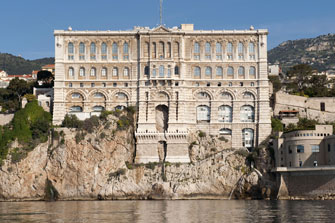Who’s Afraid of the
Big Bad Shark?

A blacktip reef shark. Photo: T. Ameller. Musée Océanographic de Monaco.
Sharks have a seriously bad rep, but just because they chomp on an occasional surfer doesn’t mean that they are truly vicious animals. Now the Musée Océanographique de Monaco has set out to rehabilitate the reputation of this endangered fish, whose disappearance could seriously disrupt the ecosystems of the world’s oceans and seas, with potentially devastating consequences.
The museum’s exhibition, “Requins: L’Expo-Sensation,” offers some compelling statistics to dispel the myths about these reputed man-eaters. Of the nearly 500 species of sharks, only five are dangerous to humans, and even they prefer their usual diet to people-flesh Only around 10 people are killed by sharks every year. Compare that with the record for cone snails, which kill around 20 humans a year; jellyfish, 50; crocodiles, 2,000; snakes, 100,000; mosquitos, 800,000 (by passing on malaria); and automobile accidents, 1.2 million. Even elephants, hippopotami and dogs kill more humans every year than sharks do. That may be comparing apples with oranges, but these numbers nevertheless give an idea of the relative harmlessness of most sharks.
In the other direction, the show points out that humans kill over 100 million sharks per year, mostly to make shark fin soup, considered a great delicacy in China. The fishermen specializing in this niche hack off the animal’s fin and throw the carcass, often still alive, back into the water to die of suffocation or be eaten by other fish. A gory film in the exhibition shows this process, called “finning,” which has been banned in some places but is still widespread.
Sharks have been around for some 400 million years and had never been hunted by a super-predator until humans came along. If they become extinct, the marine ecosystem will be seriously disturbed as the populations of some creatures below them on the food chain explode.
Sharks may be intelligent and vital to the eco-balance of the oceans, but that doesn’t mean that it is easy to make an emotional connection with these cold-blooded, fast-swimming, sharp-toothed predators. The exhibition takes a step toward remedying this problem by allowing visitors to pet small sharks swimming in a special pool. When they see a hand beckoning them, these cute little

The petting pool. Photo: T. Ameller. Musée Océanographic de Monaco.
creatures come right up to the edge and stick their noses out of the water, seeking caresses like a housecat.
Visitors can see larger live sharks in the museum’s aquarium, and taxidermied and preserved specimens of various species in an exhibition room. In the same room, a big interactive “fresco” with attractive graphics provides information on a species when a

The interactive fresco. Photo: T. Ameller. Musée Océanographic de Monaco.
visitor approaches its moving image. And, even though this is a pro-shark exhibition, the museum couldn’t resist including in the fresco a great white shark like the one in the movie Jaws, which lunges at those who approach it, its jagged-tooth maw wide open to take a bite. It’s not for nothing that the museum calls this exhibition “sensational.”
The exhibition also provides a good excuse to visit this century-old museum perched on the Rocher (Rock) in Monte Carlo, near the principality’s palace and overlooking the

The view of the museum from the sea. Photo: M. Dagnino. Musée Océanographic de MonacoMediterranean. Its aquarium is being modernized, but the museum itself still has a wonderful Old World feeling and lots of interesting specimens, many of them collected by Jacques Cousteau during his exhibitions.
The museum’s director, Robert Calcagno, is so passionate about the subject of sharks and their need for protection that he has written an illustrated book on the topic called Requins: Au delà du Malentendu (Editions du Rocher).
Musée Océanographique de Monaco: Monte Carlo, Monaco. Tel.: (377) 93 15 36 00. Open July-Aug., 10am-8:30pm; Sept., 10am-7pm; Oct.-March, 10am-6pm; April-June, 10am-7pm. Admission: €14. www.oceano.mc
Click here to read all of this week’s new articles on the Paris Update home page.
Reader Reaction: Click here to respond to this article (your response may be published on this page and is subject to editing).
Click here for more C’est Ironique! columns.
Support Paris Update by ordering books from Paris Update’s Amazon store at no extra cost. Click on your preferred Amazon location: U.K., France, U.S.
© 2013 Paris Update
Favorite